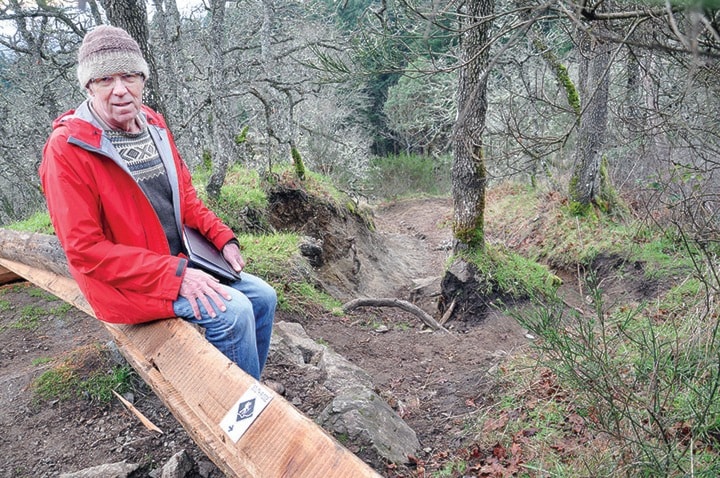Hike up a leg of Whittaker trail on the south end of Mount Douglas Park, and small footpaths melt into the forest on either side. This park may be Saanich’s crown jewel, but it’s also an endless warren of trails carved by bushwhacking.
Unsanctioned trails are starting to take a toll on the park, in terms of soil erosion and habitat loss. Saanich is taking steps to keep hikers steered in the right direction using signposts and markers on what can be a disorienting and confusing trail system.
At the same time, the parks department has started blocking offshoot trails using split cedar fences, particularly on the steep South Ridge trail. Between the summit and Harrop trail, small fences cut across no less than eight spur lines jutting off from the main trail, over a span of a few hundred metres.
“Mount Doug has a labyrinth of trails. Some are sanctioned and many others were created over the years,” said Rae Roer, manager of Saanich parks. “We are now taking the deliberate step of identifying sanctioned trails.”
South Ridge trail has signposts and markers pointing the way, and is the second major trail to be marked and fenced. This summer, Saanich plans to install signposts at every major trail intersection throughout the park, a large project and a key part of the effort to keep people on the beaten path.
“Once trails are marked we’ll look at closing and restoring areas. Some areas we might use fallen trees, and other areas split rails,” Roer said. “In some cases nature will take its course, and other areas will need help along the way. But it’s a bit chicken and the egg. Do we start on restoration before changing people’s hiking patterns? We may need to do some public education on why we are doing what we’re doing. I hope we get quiet compliance.”
About halfway up South Ridge trail neighbourhoods of Saanich and Victoria break into view, and a small fence provides a place to sit. Most, but not all, hikers headed to the summit on this sunny winter day obey the trail markers.
Mount Douglas Park Society president Darrell Wick points out that as an urban forest amid a growing city, the park sees a growing number of visitors and is under more threat of erosion year over year.
“If we want to maintain this as a natural park, you can’t have trails going off every five or 10 metres,” Wick said.
“We want to funnel people to the main trails so we stop this stuff,” he said, pointing to yet another trail veering off into the brush.
“There are a lot of little ones. We have no idea why they are there. They’re not deer trails,” he said. “It only takes a few people to walk across the brush to make a trail.”
Over the past century, Mount Doug has been abused in many ways.
Wick said 40 years ago the sand gullies that cut down the south side of the hill were used for motorcycle hill climbs. After that ended, mountain bikers started cutting single track trails through the park. These days, it’s walkers and runners who veer off main trails. The sand gullies in particular are eroding rapidly from rain and footsteps, and vegetation has failed to take hold.
“We want the park to be able to handle more people, while maintaining this as a pristine natural park. It is a challenge,” Wick said. “Over the last 10 years, small trails have turned to big trails as the population using the park increases.”
For restoration to work, Saanich is depending on people co-operating – knee-high split rail fences do little to block a hiker. Roer said over time, parks staff might obscure trailheads by planting vegetation, but they’ll largely depend on nature to absorb old paths.
“If it doesn’t get used, it will fill in, branches will grow over and fill in the space,” he said. “This will reduce erosion and provide more habitat for wildlife, and preserve habitat for the ecosystem.”
Wick said society volunteers might be more aggressive in terms of killing offshoot trails. “We’ll push to do park restoration. There’s no point to leave it like this. It needs planting.”
editor@saanichnews.com
